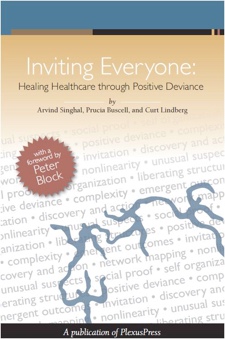

What explains the enhanced psychological resilience of students at VMBO schools in the Netherlands? The Positive Deviance Approach in Action —- Martine Bouman, Sarah Lubjuhn, & Arvind Singhal (2014) —- http://localhost:3000/#
Martine Bouman, Sarah Lubjuhn, & Arvind Singhal (2014)

Invite Everyone – Healing Healthcare through Positive Deviance —- Arvind Singhal —- https://example.com
Positive Deviance (PD) is an approach to social change that enables communities and organizations to discover the wisdom they already have, and then to act on it. The premise of PD is that in every community there are certain individuals or groups whose uncommon practices or strategies enable them to find better solutions to problems than neighbors and peers who have access to the same resources. PD is led by people in the community who help identify and spread the successful practices. Ideas for change are more likely to be accepted and adopted when they are based on existing local wisdom than they are when outside exports try to impose them. This book tells the remarkable story of how a people-centered approach to organizational and social change, accompanied by sound scientific and technical expertise, yielded positive quality outcomes for ordinary citizens, health care institutions and their patients, and society in general. This work draws upon the collective wisdom and experience of infection control practitioners, doctors, public health authorities, nurses, social and organizational change practitioners, health care administrators, patients and front line workers. Additional benefits of use of the PD process to fight infection turned out to be improved workplace relationships, Positive Deviance (PD) is an approach to social change that enables communities and organizations to discover the wisdom they already have, and then to act on it. The premise of PD is that in every community there are certain individuals or groups whose uncommon practices or strategies enable them to find better solutions to problems than neighbors and peers who have access to the same resources. PD is led by people in the community who help identify and spread the successful practices. Ideas for change are more likely to be accepted and adopted when they are based on existing local wisdom than they are when outside exports try to impose them. This book tells the remarkable story of how a people-centered approach to organizational and social change, accompanied by sound scientific and technical expertise, yielded positive quality outcomes for ordinary citizens, health care institutions and their patients, and society in general. This work draws upon the collective wisdom and experience of infection control practitioners, doctors, public health authorities, nurses, social and organizational change practitioners, health care administrators, patients and front line workers. Additional benefits of use of the PD process to fight infection turned out to be improved workplace relationships, healthier and more resilient organizational cultures, and expanded networks of people in many fields and geographical locations who shared ideas, resources and the inspiration of their own contributions to saving lives.

